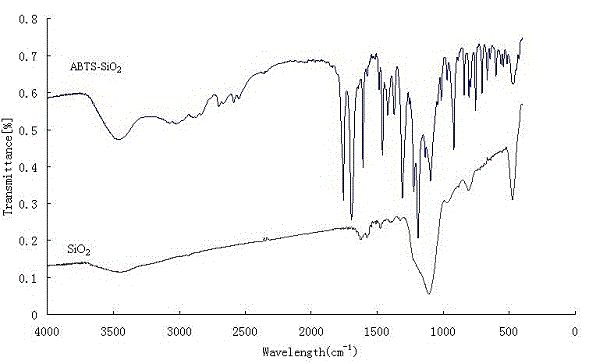Laccase mediator ABTS-SiO2 nanoparticles, as well as preparation method and application thereof
A nanoparticle, laccase mediator technology, applied in chemical instruments and methods, immobilized on or in inorganic carriers, water pollutants, etc., can solve the problem of low efficiency, difficult recovery, and increase the cost of laccase mediator use problems, to reduce the cost of use, reduce secondary pollution, and facilitate recycling and reuse.
- Summary
- Abstract
- Description
- Claims
- Application Information
AI Technical Summary
Problems solved by technology
Method used
Image
Examples
Embodiment 1
[0016] Example 1 Laccase Mediator ABTS-SiO 2 Preparation of nanoparticles
[0017] (1) Weigh 0.548g of ABTS and dissolve it in 10mL of anhydrous methanol, then add 0.224g of potassium tert-butoxide, ultrasonically disperse until uniformly dispersed, stir and react for 2h, filter and wash with anhydrous methanol for 3 times, and then in 45℃ Dry in an oven to remove methanol to obtain off-white 2,2-azino-bis(3-ethyl-benzothiazole-6-sulfonic acid) dipotassium salt;
[0018] (2) Weigh 0.524g of triphenylphosphine and dissolve it in 20mL of anhydrous acetonitrile, carefully drop about 104μL of bromine in an ice bath until the solution remains light yellow, then add a small amount of triphenylphosphine to make the solution become Colorless, dibromotriphenylphosphine was obtained;
[0019] (3) Add 2,2-azino-bis(3-ethyl-benzothiazole-6-sulfonic acid) bis(3-ethyl-benzothiazole-6-sulfonic acid) prepared in step (1) to the dibromotriphenylphosphine prepared in step (2) Potassium salt,...
Embodiment 2
[0023] Example 2 ABTS-SiO2 Regenerative use of nanoparticles as laccase mediators
[0024] (1) Take the laccase mediator ABTS-SiO 2 Add 40mg of nanoparticles into 2mL of acetic acid buffer solution with pH=4.5, then add 2.0U of laccase, shake the reaction until complete, until the laccase mediator ABTS-SiO 2 Nanoparticles turn green;
[0025] (2) Add 30 uL of ascorbic acid with a molar concentration of 0.2 mol / L to the mixed liquid after the enzyme-catalyzed reaction in step (1), and stir to react until the laccase mediator ABTS-SiO 2 The nanoparticles changed from green to light yellow, then the reaction mixture was centrifuged, the supernatant was poured off, and the precipitate was washed 5 times with distilled water to recover the obtained laccase mediator ABTS-SiO 2 The nanoparticles are further reused.
Embodiment 3
[0026] Example 3 ABTS-SiO 2 Application of Nanoparticles as Laccase Mediators for Dye Removal
[0027] (1) Take the laccase mediator ABTS-SiO 2 Add 40 mg of nanoparticles to 2 mL of acetic acid buffer solution with pH = 4.5, then add 0.5 U of laccase, then add 0.04 mg of dye indigo carmine, shake the reaction until complete, and the blue solution becomes colorless;
[0028] (2) Add 30 uL of ascorbic acid with a molar concentration of 0.2 mol / L to the mixed solution after the enzyme-catalyzed reaction in step (1), stir and react for 1 min, centrifuge the reaction mixed solution, pour off the supernatant, and then wash the precipitate with distilled water 5 times, the obtained laccase mediator ABTS-SiO was recovered 2 Nanoparticles are used repeatedly as described above. Its effect on the removal of indigo carmine and the changes in repeated use are shown in image 3 , it can be seen from the figure that after 4 times of recycling, it still maintains a high removal effect on...
PUM
| Property | Measurement | Unit |
|---|---|---|
| particle diameter | aaaaa | aaaaa |
Abstract
Description
Claims
Application Information
 Login to View More
Login to View More - R&D
- Intellectual Property
- Life Sciences
- Materials
- Tech Scout
- Unparalleled Data Quality
- Higher Quality Content
- 60% Fewer Hallucinations
Browse by: Latest US Patents, China's latest patents, Technical Efficacy Thesaurus, Application Domain, Technology Topic, Popular Technical Reports.
© 2025 PatSnap. All rights reserved.Legal|Privacy policy|Modern Slavery Act Transparency Statement|Sitemap|About US| Contact US: help@patsnap.com



